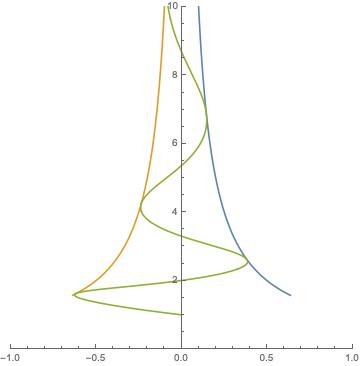This is related to finding out the time it takes for the capacitor to discharge in a full-wave rectifier (link to ee.se), and it's of the form:
$$\mathrm{e}^{-x}=\sin(x) \tag{1}$$
To my knowledge it's impossible to determine $x$ analytically, because whether with $\ln()$ or $\arcsin()$, one term gets buried. Using the exponential equivalent formula for $\sin(x)$ doesn't seem to work, either. But I'm not fluent in math, so I'm asking it here: is it possible, maybe with some tricks, cheats, anything?
I shouldn't have presumed people to know what a full-wave rectifier with parallel RC load is or does, so for the sake of clarity this is what interests me:
The (ideal) theory is that the sine wave charges the capacitor. At the peak and for a short interval after it (on the downslope), the voltage across the capacitor is the same as the sine. When the two slopes are equal, the capacitor voltage is no longer a sine but an $\mathrm{e}^{-x}$, continuing from the last voltage value. The sine has an absolute value, so the second half of the period sees the value of the sine rising again, until it meets the discharging exponential — this is what is needed here. The cycle continues:

For the sake of simplicity, here, on math.se, the question deals with a generic formula, (1), not the absolute value of it, and no complications with finding out the time and value when the capacitor voltage stops being a sine and continues as an exponential. There are also no time constants involved, or frequencies, therefore, the simplified version looks like this:

The capacitor discharges with the blue trace until it meets the red trace. Only the first point of intersection is needed (black dot), any other subsequent points are discarded (green circle). If this is solved, then $\mathrm{e}^{-ax}=\sin(bx)$ can also be solved, and even the moment when the waveform switches shapes, though I suspect that will be a tad more complicated (and not part of this question).



Best Answer
You can find a REALLY COMPLICATED analytic expression for the solution by means of the Lagrange inversion theorem. After some simplifications the answer is $$x = \frac{1}{2}+\sum_{n=2}^\infty\frac{1}{n!\,2^n}\sum_{k=1}^{n-1}(-1)^k n^{\overline k}B_{n-1,k}(a_1,a_2,\ldots,a_{n-k})$$
where $n^{\overline k}$is the rising factorial, $B_{i,j}$ are the Bell polynomials and $a_j$ is given by $$a_j = \begin{cases} -\frac{1}{2 (j+1)} & j \equiv 1 \pmod 2 \\ 0 & j \equiv 2 \pmod 4 \\ \frac{1}{j+1} & j \equiv 0 \pmod 4 \end{cases}$$